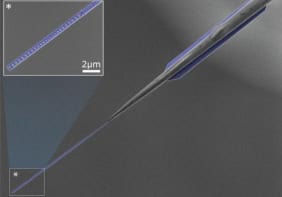
A grooved surface that collects water by encouraging large dew droplets to form rapidly and then trickle away has been created by Pierre-Brice Bintein and colleagues at the Superior School of Industrial Physics in Paris. The researchers say that a square metre of the surface could be used to collect more than 500 ml of water in one night. The team believes their technique could provide people in some arid regions with a reliable source of fresh water.
When an inclined surface is left outside overnight in relatively cool temperatures, dew droplets will form and grow. A droplet will dislodge when its weight overcomes its surface adhesion and collecting these droplets can provide a vital source of clean, fresh water in arid climates. However, the technique is not particularly efficient with conventional surfaces because droplets can remain stubbornly pinned to inclined surfaces – and then evaporate when the surface heats up in the morning.
Researchers have reduced this sticking time using ultra-smooth and micropatterned surfaces. Droplets on these surfaces experience less of a pinning force and are therefore at shed at smaller sizes.
Bigger droplets
Another way of improving water yield is to boost the rate at which droplets form on the surface. This is important in many places where dew formation is sporadic – rather that occurring all night. To deal with this issue, the researchers created a surface that forms large droplets more quickly.
Made from a wafer of silicon dioxide, their surface has deep, micrometre-wide grooves etched into it. Bintein and colleagues tested the surface by placing it in a climate-controlled chamber, alongside two smooth-surface wafers. They then took videos of dew formation on each surface for two hours.

Insects inspire water-repellent material
The videos reveal that dew collects initially inside the grooves, forming long filaments of water. As it builds up, the water in some filaments spills over into adjacent grooves, forming droplets. Since multiple droplets can be connected by the same filament, emerging pressure gradients caused smaller droplets to drain into larger ones, causing groups of droplets to coalesce into a small number of large droplets. Whereas droplets on the smooth surfaces only began to shed after two hours, the researchers observed shedding after just half an hour on their grooved surface.
Bintein’s team is confident that their technique will allow for an effective way to capture up to 500 ml litre of water per night, provided that resilient micro-grooving can be affordably manufactured on large scales. With many communities now facing an increasingly uncertain access to fresh water, the discovery could help many people in the coming decades.
The surface is described in Physical Review Letters.



